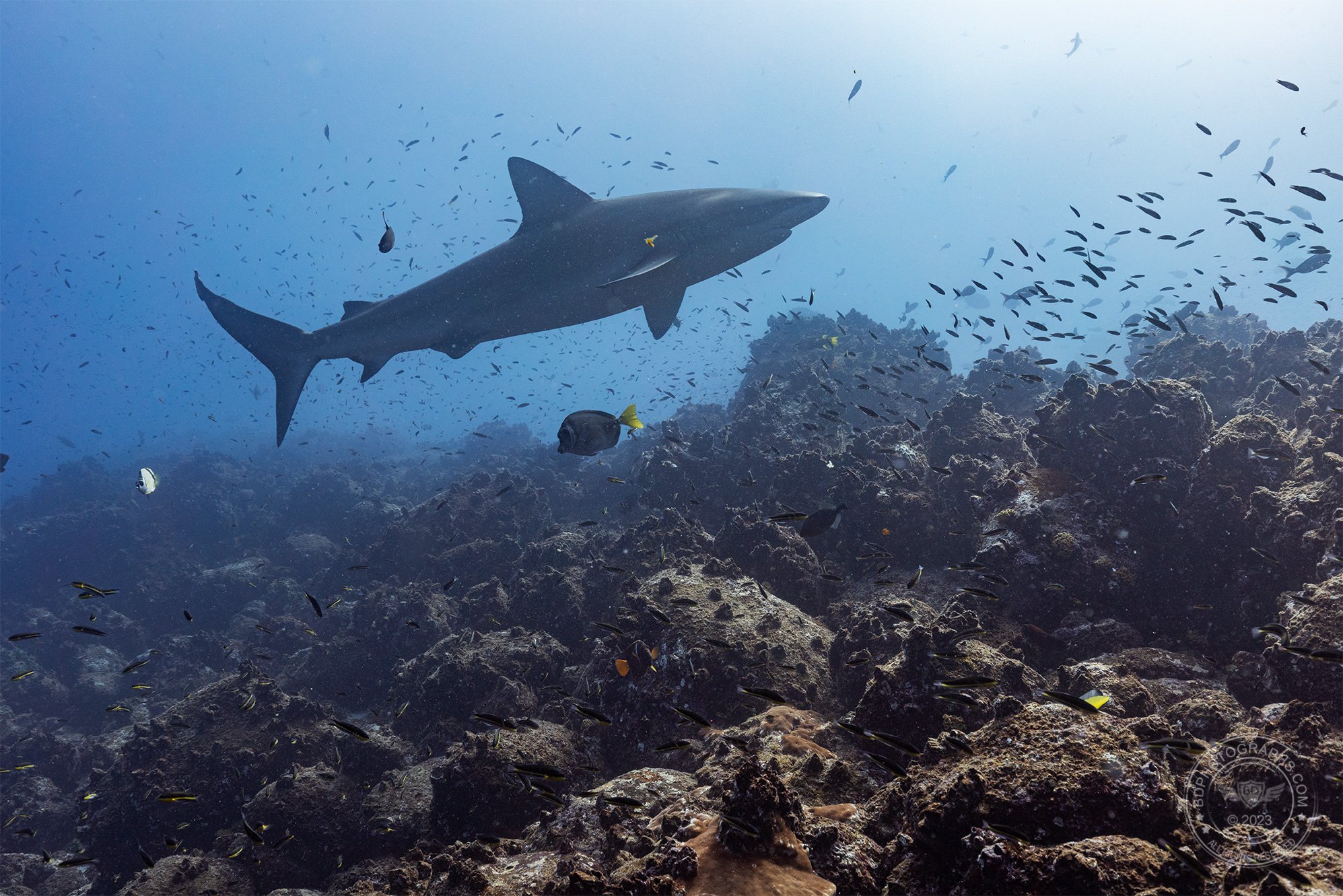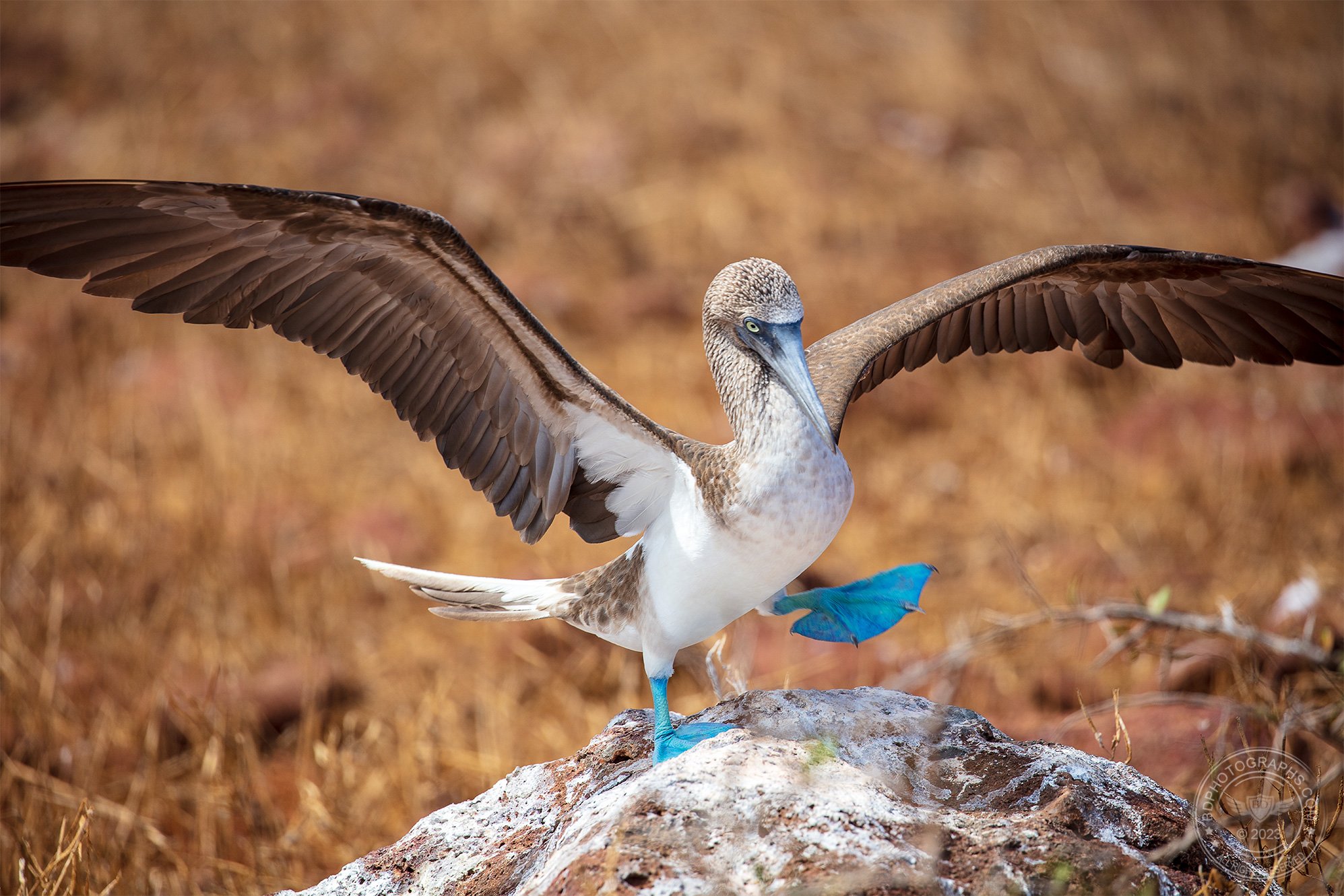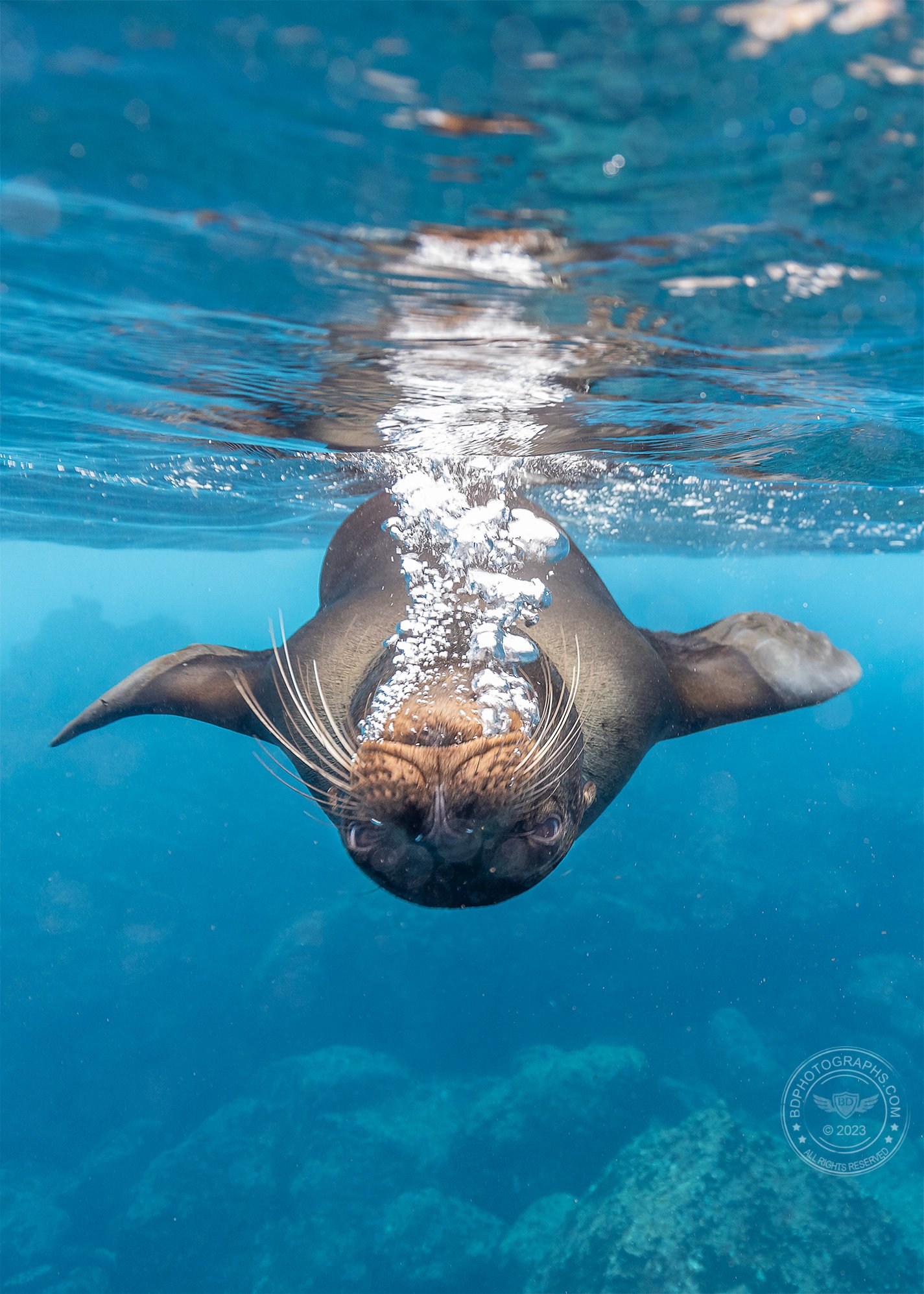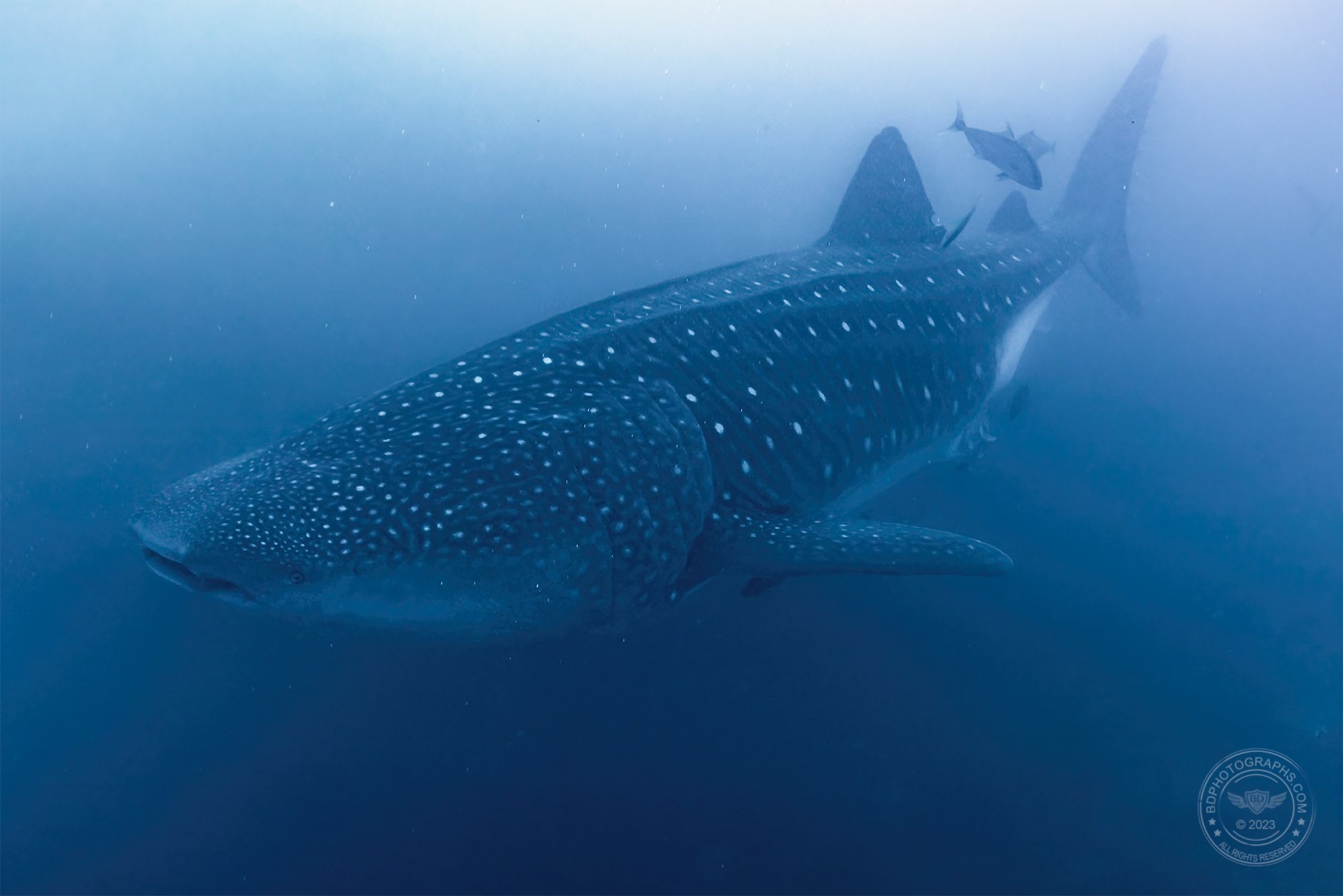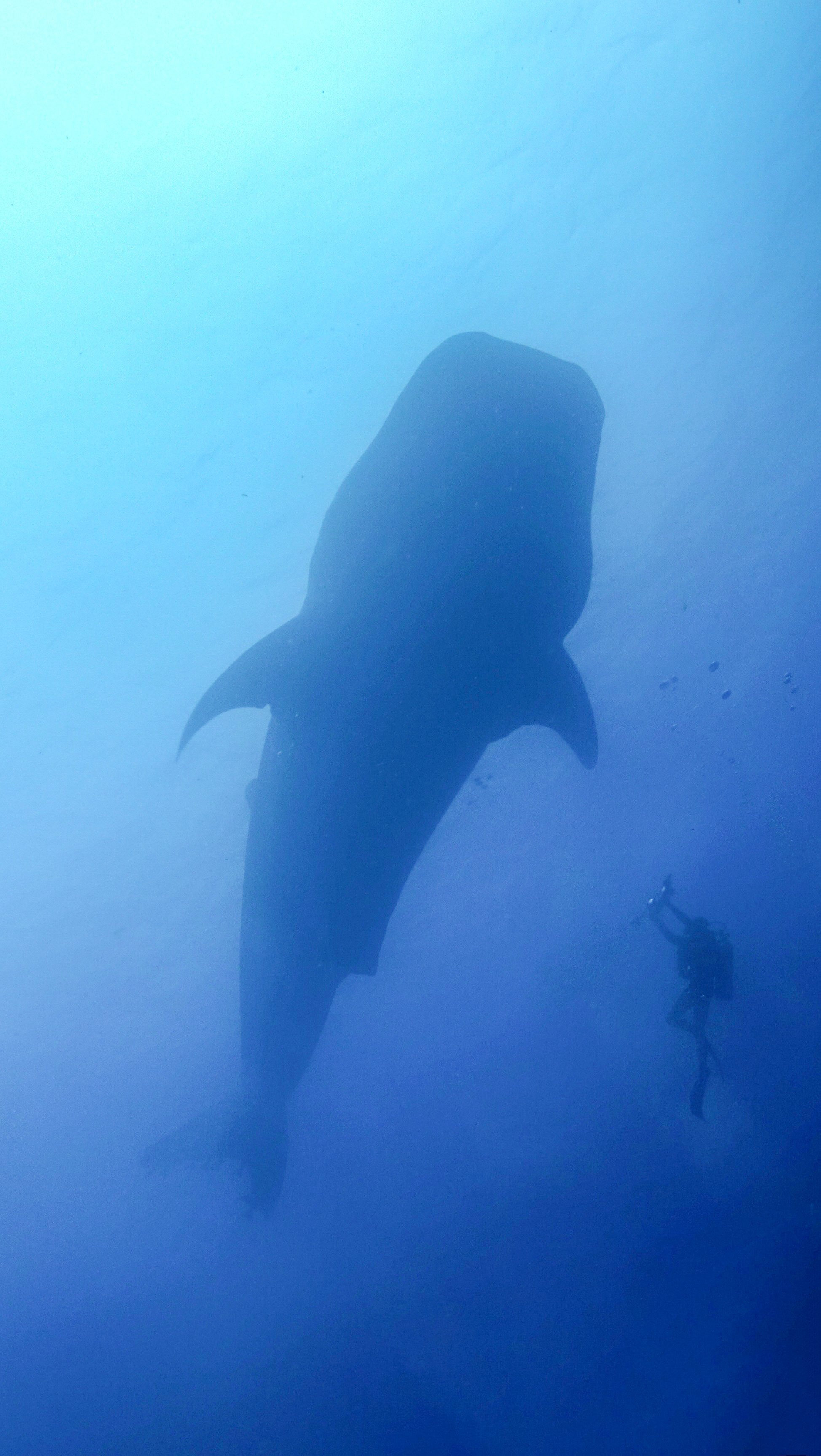Six years in the making (and postponed by a global pandemic), my trip to the world famous Galápagos Islands finally arrived in 2023. Galápagos is a rare opportunity for a variety of underwater and topside wildlife photography, including endemic species and uniquely famous animals. For underwater photography I shot entirely with a Canon R5 mirrorless body with the EF 16-35mm F/4L IS wide angle lens. The EF F/4L IS is an outstanding lens, even nearly 10 years after its introduction: tack sharpness, minimal distortion, and beautiful detail. A Nauticam housing and two Sea & Sea strobes complete the underwater rig. Topside photography included birds, reptiles, and pinnipeds, so I needed a versatile telephoto lens: the EF 100-400 f/4.5-5.6L IS II, which remains my favorite telephoto zoom lens. Though not the fastest performing glass, it is exquisitely sharp throughout its focal range and is a great hand-held lens for general daytime wildlife photography.
Wolf and Darwin Islands (blue circle) are the primary dive locations and even more remote than the rest of the Galápagos Islands. The main airport is centrally located but still a 16-hour boat ride from the dive sites.
The journey begins with a redeye from New York to Ecuador’s high-elevation capital, Quito, with a connection to Avianca’s flight to Baltra Island, 600 miles off the coast of the mainland. In Baltra I jump on a small inflatable tender (aka “panga” in Latin America) that brings me to the Humboldt Explorer, the live-aboard dive yacht that will become home for the next week.
One of the unique features of Galápagos is its remoteness and difficulty to visit. Wolf and Darwin Islands, where we will do most of our diving, are uninhabited (by people), undeveloped and significantly distant from our arrival port in Baltra: a sixteen-hour overnight crossing reveals the first glimpse of Wolf on the morning horizon. A towering bluff overlooking the mighty Pacific, Wolf Island truly is a wild place where nature is free and the ocean is powerful.
The Galápagos Shark is a large requiem shark that looks similar to other members of this family: it skews larger than reef sharks and has a leaner build than bull sharks. Despite its name the shark is found in many parts of the world, typically off tropical oceanic islands.
Pelagic diving is not for beginners. Unlike tropical reef diving, open ocean diving is more intense and demands a higher task load, especially when diving with a large camera. Conditions are dynamic and things can escalate quickly. All of our dives require transferring from the mother ship to the panga, which whisks us away in choppy seas toward the drop-off point. At the dive guide’s instruction (“on the count of three”), all divers back-roll into the water (i.e. fall backward off the side of the inflatable). It’s critically important to time this correctly so that all divers splash into the water at the same time, otherwise we could land on top of each other with heavy aluminum air tanks. Once in the water, the currents begin to pull, so we descend quickly and land together as a group at the dive site, usually a rocky outcrop about 70-80 feet deep. Again, time is of the essence, and we don’t have the luxury to drop slowly or to explore as we would on a calm tropical reef. We must get to the meeting point with the group, otherwise the current could pull us away.*
The blue-footed booby, one of Galápagos’s famous sea birds
With brisk currents and strong surge, the cloudy, nutrient-rich water is thick and heavy. Distant hammerheads patrol the deep open blue. Like many sharks they know how to remain just on the edge of visibility, at times making you question whether what you saw was an illusion. I can hear the squeaky chatter of dolphins communicating. They will make several appearances but move too quickly for a good photo. Schools of fish dance in the current. Behind me a large Galápagos shark has made a close pass near the ledge.
My favorite encounter, and ultimately my one portfolio shot from this trip, is quite unexpected. As we conclude a dive near Wolf Island we encounter playful sea lions in the shallows. We quickly shed our dive gear and grab our snorkels for a closer look at these majestic pinnipeds. And how lucky we are! In what seems like a ballet performed exclusively for us, the sea lions put on an amazing display of agility and grace: bobbing, gliding, and spinning. I notice a sea lion swimming toward me so I remain motionless and prepare to fire off a few shots — in a split second the sea lion flips over and exhales a burst of bubbles, then cuts left and down into the deep.
Although the philosophy in Galápagos is that you “never know what you will see”, on these dives we engage our peripheral vision, looking for that unmistakeable giant shadow to emerge from the darkness. We are planted on the rocky outcrop, observing the sea life in the current almost to the point of boredom. Then, with a shaking rattle, the dive guide musters the group and directs us into the open blue. The group does not see it yet, but we know from the guide’s excitement that this is something big. And then it appears, first as a lumbering blot of distant ink, moving darkness, eventually coming into spectacular view.
Perhaps the most unforgettable part of encountering a whale shark is feeling the volume of water that is displaced as the school-bus-sized fish swims past you
The author meeting a very large whale shark
I am very fortunate to have seen whale sharks several times in three different oceans, and it is not lost on me that many divers will spend a lifetime seeking these elusive giants. This whale shark is enormous (possibly pregnant), and with effortless sweeping of her caudal fin, it is almost impossible to keep up with her.
In addition to multiple dives in Wolf and Darwin Islands, we spent two afternoons observing wildlife on land: on North Seymour and Santa Cruz Islands. North Seymour was extremely productive, including encounters with the famous blue-footed boobies, frigates, as well as the Galápagos land iguana. Later as we hiked toward a field of boulders on the shoreline, we observed sea lions (mother and pup) and the Galapagos marine iguana. On Santa Cruz, we capped off the trip with an expedition up to the lush highlands to meet perhaps the islands’ most famous ambassador: the giant tortoise. On all the land tours my 100-400mm telephoto was perfect for close-up detail shots and the variable microclimates meant I didn’t have to wait long for favorable light conditions.
For wildlife enthusiasts and avid divers, Galápagos is among the ultimate destinations. I hesitate to say once-in-a-lifetime because I hope to return…
The real inspiration for Godzilla. Despite its fearsome appearance, the Galápagos marine iguana is a shy herbivore.
No trip to Galápagos is complete without seeing its most famous ambassador: the giant tortoise
*Some ask: what would happen if someone missed the dive meeting point and drifted in the current? Hopefully there would be more than one person, as you should always stick with your dive buddy. Whether in a group or alone, if someone was adrift, the proper thing to do would be to ascend slowly and send up a surface marker buoy (essentially a long inflatable brightly colored tube about 6 feet tall — I have one as part of my standard gear for every ocean dive). The panga driver would be in the area would likely see the marker to come pick up the lost diver. We also had other protocols in case of emergency including a GPS beacon locator. Thankfully no one separated from the group.

